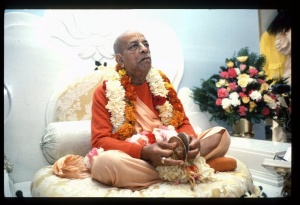CC Madhya 18.67 (1975)

A.C. Bhaktivedanta Swami Prabhupada
TEXT 67
- 'śrīvana' dekhi' punaḥ gelā 'loha-vana'
- 'mahāvana' giyā kailā janma-sthāna-daraśana
SYNONYMS
śrī-vana—Śrīvana; dekhi'-seeing; punaḥ—again; gelā—went; loha-vana—to Lohavana; mahā-vana—to Mahāvana; giyā—going; kailā—performed; janma-sthāna—birth site; daraśana—seeing.
TRANSLATION
Śrī Caitanya Mahāprabhu then visited Śrīvana and Lohavana. He then went to Mahāvana and saw Gokula, the place of Lord Kṛṣṇa's early childhood pastimes.
PURPORT
Of Śrīvana (also called Bilvavana), the Bhakti-ratnākara states, devatā-pūjita bilvavana śobhāmaya: "The beautiful forest of Bilvavana is worshiped by all the demigods." About Lohavana, Bhakti-ratnākara (Fifth Wave) states:
- lohavane kṛṣṇera adbhuta go-cāraṇa
- ethā loha-jaṅghāsure vadhe bhagavān
"At Lohavana, Lord Kṛṣṇa used to tend cows. The demon named Lohajaṅgha was killed at this place."
Mahāvana is described as follows in Bhakti-ratnākara (Fifth Wave):
- dekha nanda-yaśodā-ālaya mahāvane
- ei dekha śrī-kṛṣṇa-candrera janma sthala
- śrī-gokula, mahāvana--dui 'eka' haya
"Behold the house of Nanda and Yaśodā in Mahāvana. See the birthplace of Lord Kṛṣṇa. Mahāvana and the birthplace of Lord Kṛṣṇa, Gokula, are one and the same."